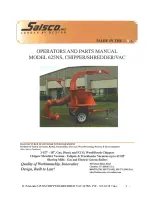
ASSEMBLY
ZIPPER MASCHINEN GmbH www.Zipper-Maschinen.at
37
ZI-HAEK15000
•
Check the carburettor for external dirt and dust and clean it with dry compressed air if neces-
sary.
•
Check the lock nuts and screws for tightness. (Screws or bolts loosened by vibrations can lead
to accidents!).
•
Check the engine oil level
•
Level the machine with the support wheel and secure the wheels with chocks against shifting.
14.3.1
Checking the engine oil level
N OTE
ATTENTION!
For transport motor oil has been drained. Fill up with 4-stroke quality motor
oil before first operation! Failure to do so will result in permanent motor damage and void
guarantee!
N OTE
A too low oil level will cause damage to the engine and shorten the service life of the ma-
chine. Therefore, check the motor oil level before every start and if necessary fill up with oil.
1.
To check the engine oil level, place the machine on a flat, level sur-
face. Switch off the motor and wait for ten minutes to allow the
circulating oil to collect in the oil pan.
2.
Unscrew the oil-dipstick and wipe with a clean, lint-free cloth or a
non-fibrous paper towel.
3.
Push the oil-dipstick back into the opening as far as possible, but
do not screw it in. (Make sure that the oil-dipstick is really pushed
in completely - occasionally it gets jammed).
4.
Pull out the oil-dipstick again and check the oil level. There are
two markings for this - see illustration on the left.
5.
If the oil level is low, fill up the recommended engine oil to the up-
per rim at the maximum (maximum filling volume: see technical
data)
6.
Insert the oil-dipstick again and retighten it.
7.
Wipe away oil residues.
14.3.2
Check the fuel tank level
N OTE
Follow the safety instructions for fuel inspection.
Filter the fuel when refueling to prevent
foreign particles from entering the combustion chamber. Wipe up any fuel that has spilled.
Procedure:
1.
refuel outdoors only!
2.
Before removing the tank cap, switch off the engine
and allow the machine to cool down.
3.
Clean the tank cap area.
4.
Carefully remove the tank cap.
5.
level check in the form of a visual inspection.
6.
Fill up with fuel if necessary.















































